
Rolls-Royce Owners' Club
of Australia Library
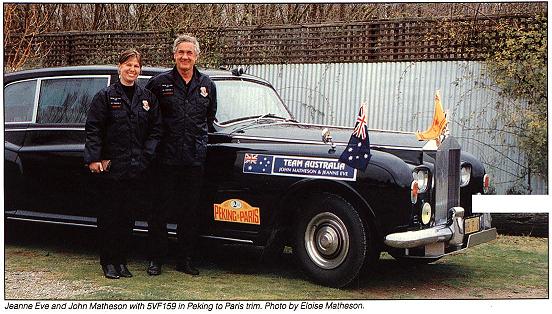
Preparing a Phantom V for the Peking to Paris Motor Challenge
By John Matheson, 1997
There were a number of challenges in preparing the
Phantom V for a long distance motor rally. They
included doubtful roads, high altitude driving and
low octane fuel. We were told by the rally organism
that we would need at least eight inch road clearance
for creek crossings in Nepal and for
broken roads in Tibet. We would need strengthened
suspension for the corrugated roads in Western China
and we would need to prepare the car for
70 octane unleaded, the only petrol that would be
available in China and Tibet. All of these parameters
produced their own difficulties and we have
set about a programme over two years to try and
deal with these problems.
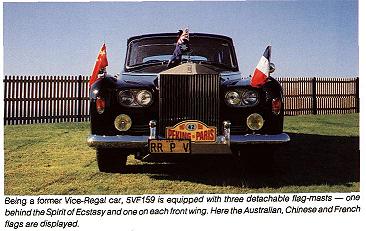 Our own criteria were that the car should be altered
as little as possible and should be left in a state
so that it could be returned to pristine condition
at the end of the rally. We have no intention of
seeing this car destroyed or even damaged. All
of the modifications made to the car are reversible but
some of the modifications have so improved the car
that they will not be altered and I will come to this later on.
Our own criteria were that the car should be altered
as little as possible and should be left in a state
so that it could be returned to pristine condition
at the end of the rally. We have no intention of
seeing this car destroyed or even damaged. All
of the modifications made to the car are reversible but
some of the modifications have so improved the car
that they will not be altered and I will come to this later on.
The Engine
Fortunately this is a 6.2 litre V-8 engine of good
design with high quality parts. It already has
hardened valve seats and high quality component
pistons so the problems with pre-ignition and
poor quality fuel would be less in this car than
other makes of lesser breed. This car has only done
72,000 miles and them is no evidence of any
mechanical dysfunction in the car and therefore
a decision was made that no modifications would be
made internally to the mechanical structures and we
would go au natural from that point of view. This
particular car was supplied with the so
called colonial kit and thus the engine compression
ratio is 8:1 and not 9:1 as in the home market
Phantom V. This has made some of the adaptions
for a low octane fuel easier. The rally organism
had recommended a maximum compression ratio of
7.5:1 but we have decided to run with the 8:1
compression ratio unaltered. Even though it is
possible to change the head gaskets and lower
the compression ratio we felt that this might produce
more harm than good in the end. The only
modifications we have carried out to the engine
is to put a fuel catalyst on the end of the fuel
line in the
hope that this will speed the ignition of the fuel
by polarising the fuel and giving us less preignition.
Whether these devices work or not is doubtful.
This particular one is the best recommended one and
contains a tube with five different metals in it.
It is supposed to release a little bit of copper
into the fuel and also to polarise the fuel line.
Certainly when we put the device in there was an
instant drop in the CO2 exhaust
compression reading so it may be having some effect.
The other method of catering to the poor fuel
condition is that we will take fuel octane enhancers
with us. This again only goes part of the way
to solving the problem and provides about half the
effect of tetraethyl lead. From the point of
view of this car with its low revving engine and
hardened valve seats the issue for us is more of
low octane rather than my worry about damage to
valve seats. We will be carrying with us larger
needles for the two S.U. carburetters so that
when we go to high altitudes we can change the
needles to make the fuel leaner to overcome the
problem of lack of oxygen. In this trip we will
climb into heights of over 17,000 feet where the
atmospheric pressure drops to 44% and both the
passengers and the car will have trouble breathing.
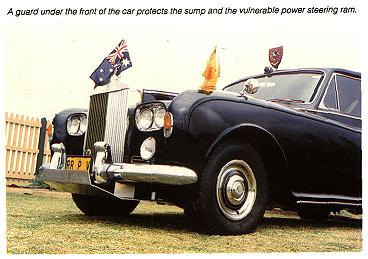 It was thought prudent to change the radiator core.
In addition to this two auxiliary electric fans
were put on the front of it to provide extra cooling.
One of the problems of high altitude would be
boil-off of coolant and rupture of the cooling system.
All new radiator hoses have been fitted in
association with the new radiator core.
It was thought prudent to change the radiator core.
In addition to this two auxiliary electric fans
were put on the front of it to provide extra cooling.
One of the problems of high altitude would be
boil-off of coolant and rupture of the cooling system.
All new radiator hoses have been fitted in
association with the new radiator core.
The standard oil has been replaced in the engine
and we using synthetic oil of 15/50 grade. This is
to cut down friction and to improve petrol consumption
for the long distances we have to travel
between petrol stops. Hopefully it will also reduce
engine wear. As far as I can judge it has
improved fuel consumption. No other modifications
to the engine have been made other than
myself learning how to tune the carburetters to run
leanly and to retard the engine, something we
will have to do as we climb to the higher altitudes.
Tyres
Light truck radial tyres have been fitted and the
alignment has been altered to suit. This has
improved the ride of the car and they are also quieter
than the original MW-ply tyres.
Gearbox
Apart from cleaning up the gearbox we have done nothing
other than put synthetic oils in the box
to reduce friction. This not only helps fuel consumption
but will reduce wear and in particularly
will reduce the tendency of the oil to overheat when
climbing up into Tibet.
Fortunately the car already has an oil cooler. It
was designed as a processional vehicle and thus has
demands to keep the oil cool. If one had not been
fitted we would have put one on.
Differential
Differential oils can boil on climbing long hills
and at high altitudes. We have catered for this by
putting synthetic oil in the differential. The
differential also has a guard on it for rock impaction
and this also tends to cause overheating. So the
synthetic oils, I believe, are essential. The low
friction of these oils prevents heat buildup.
Undercarriage
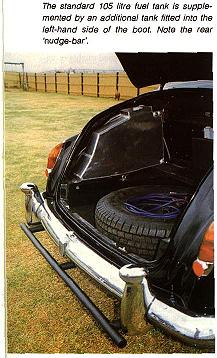 The car has been modified to cater for bad road
conditions. Three skid plates have been placed
under the car. One for the front of the engine
particularly to protect the very vulnerable steering
ram which sticks out under the front bumper. The
skid plate in the front has been curved up in
front of the bumper to provide a nudge bar and
also to protect the steering ram and the chrome
bumper A second skid plate has been fitted on the
gearbox and sump and a small third one has
been placed on the differential The front suspension
was modified by putting spacers under the
coil springs to lift the car about 1 cm and to
match the rear of the car. The rear was modified by
fitting a supplementary spring leaf. This is a
full length leaf spring. Thus there are now two led
springs on each side carrying the weight onto
the shackles. This also had the effect of lifting the
rear of the car about 1 cm. Apart from giving
extra ground clearance this
has improved the handling of
the car enormously. It no longer wallows
and accepts going around corners. The exhaust
system was then taken off the car completely
and a new exhaust system built. This has been
made in stainless steel and is recessed into the
chassis. There is no underhung exposure for the
exhaust system so that it cannot be pulled off by
rocks when the car bottoms in gutters.
The car has been modified to cater for bad road
conditions. Three skid plates have been placed
under the car. One for the front of the engine
particularly to protect the very vulnerable steering
ram which sticks out under the front bumper. The
skid plate in the front has been curved up in
front of the bumper to provide a nudge bar and
also to protect the steering ram and the chrome
bumper A second skid plate has been fitted on the
gearbox and sump and a small third one has
been placed on the differential The front suspension
was modified by putting spacers under the
coil springs to lift the car about 1 cm and to
match the rear of the car. The rear was modified by
fitting a supplementary spring leaf. This is a
full length leaf spring. Thus there are now two led
springs on each side carrying the weight onto
the shackles. This also had the effect of lifting the
rear of the car about 1 cm. Apart from giving
extra ground clearance this
has improved the handling of
the car enormously. It no longer wallows
and accepts going around corners. The exhaust
system was then taken off the car completely
and a new exhaust system built. This has been
made in stainless steel and is recessed into the
chassis. There is no underhung exposure for the
exhaust system so that it cannot be pulled off by
rocks when the car bottoms in gutters.
A nudge bar been placed in the back of the car.
This has been discreetly set just in underneath and
behind the rear bumper, allowing an exit angle for
the car so if the car does bottom coming out of
creeks it will hit this bar and not the bumper and
so will not pull the bumper out. This will also
serve as a nudge bar to allow the car to be pushed
out of creeks if it gets stuck.
Fuel System
Cars are required to have a cruising range of 350 miles.
With its fuel consumption between 8 and
11 miles per gallon and a fuel. capacity of some 20
gallons, this was not obtainable. It was
therefore decided to add an extra fuel tank in the
left-hand side of the boot. This sits in very nicely
and provides us with another 11 gallons of fuel.
We now carry a total of 33 gallons. With the
various engine modifications we now can do well
over 350 miles under ideal cruising conditions.
The auxiliary fuel tank pumps into the main fuel
tank. The fuel delivery system has been modified.
A slightly more powerful fuel pump from a Silver
Shadow has been installed. In front of this we
have put a water separator. The extra power of the
fuel pump allows fuel to be pushed through the
water separator. The water separator is required
because in Asia fuel is often contaminated with
water. The original fuel filter has also been
retained thus giving a double system. With
the modifications to the tuning, the catalyst on
the fuel line and the synthetic oils in the car the
vehicle is now capable of returning 13 miles per
gallon under good conditions.
Interior of the Car
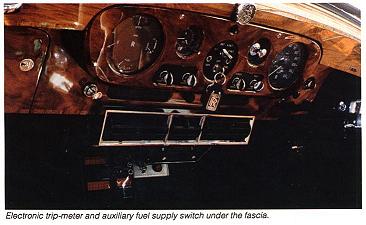 Virtually no modifications have been made to the
interior of the car. It has been left au naturel. The
boot has been modified. In addition to the auxiliary
fuel tank it now has a second battery with an
isolator switch between the batteries. The batteries
have been set up so that both will charge but
with a relay to make sure that they do not overcharge.
New Apollo batteries with 625 CCA power
have been fitted to give adequate cranking power.
The cover on the floor of the boot has been
removed to allow the insertion of a second spare
tyre with tie down bolt eyes to secure it. This has
left a rather cluttered boot but will be adequate
for a workshop for the trip. Our luggage will be
carried in soft bags in front of the rear scat. Under
the air conditioning outlet in the front of the car
are two new devices. One is a switch for the auxiliary
petrol tank, hidden fairly well from view,
and the other more prominently displayed is an odometer.
This has been attached into the
speedometer cable at the gearbox and gives us trip
distance readings which are now accurately
calibrated as well as average speeds and intermediate
trip distances. This device is really essential
for navigating to keep us on the straight
Virtually no modifications have been made to the
interior of the car. It has been left au naturel. The
boot has been modified. In addition to the auxiliary
fuel tank it now has a second battery with an
isolator switch between the batteries. The batteries
have been set up so that both will charge but
with a relay to make sure that they do not overcharge.
New Apollo batteries with 625 CCA power
have been fitted to give adequate cranking power.
The cover on the floor of the boot has been
removed to allow the insertion of a second spare
tyre with tie down bolt eyes to secure it. This has
left a rather cluttered boot but will be adequate
for a workshop for the trip. Our luggage will be
carried in soft bags in front of the rear scat. Under
the air conditioning outlet in the front of the car
are two new devices. One is a switch for the auxiliary
petrol tank, hidden fairly well from view,
and the other more prominently displayed is an odometer.
This has been attached into the
speedometer cable at the gearbox and gives us trip
distance readings which are now accurately
calibrated as well as average speeds and intermediate
trip distances. This device is really essential
for navigating to keep us on the straight
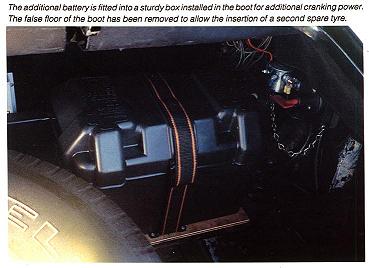 and narrow. All of the notes of the navigation will be given
in kilometres and our speedometer is in
miles so this device is necessary. A second horn button
has been added for the navigator to use.
The horn has been boosted with two additional horns and
operating them also turns on the high
beam headlights.
and narrow. All of the notes of the navigation will be given
in kilometres and our speedometer is in
miles so this device is necessary. A second horn button
has been added for the navigator to use.
The horn has been boosted with two additional horns and
operating them also turns on the high
beam headlights.
Oxygen
There will be quite a steep climb into the Tibetan plateau
and a very high chance of mountain
sickness during this trip and therefore we fitted two
oxygen bottles to the car. These lie just in
front of the front seats and are connected to a pulse
regulator to allow the navigator and driver to
take breaths of oxygen when necessary during the trip.
It will be necessary for us to preoxygenate
ourselves before any activity such as car servicing or
tyre changing.
On this journey there will be no support vehicles and
we have to be self sufficient. We have
catered to this by changing most of the wearing parts
in the car but in addition are taking spares
with up. Fortunately I have a Continental Touring Kit
with the car and that will come with us and
will be supplemented by spare radiator hoses, spare nuts
for the wheels, fan belts and a collection
of other bits and pieces that are likely to give way
including spare needles for the carburetters,
points, rotors and distributor cap. All the hoses in the
car have been replaced and some of the hose
connections that go to the power steering box near the
manifold have been insulated to prevent
them burning.
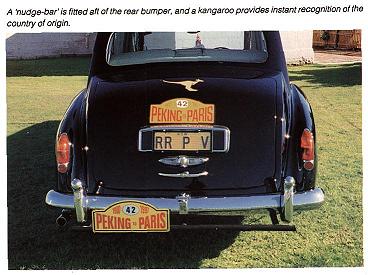 This car is now well prepared and we hope to make the
trip of 10,000 miles between Pads and
Peking without any need for anything other than routine
servicing. I would like to acknowledge the
expertise of John Vawser is preparing this car. He has
done most of the real work. The has been
supplemented by help from Pew Muir at Bond Rollbars. He
did the undercarriage work.
This car is now well prepared and we hope to make the
trip of 10,000 miles between Pads and
Peking without any need for anything other than routine
servicing. I would like to acknowledge the
expertise of John Vawser is preparing this car. He has
done most of the real work. The has been
supplemented by help from Pew Muir at Bond Rollbars. He
did the undercarriage work.
When the car returns to Australia it is intended
to put it back to its pristine state. This will involve
the removal of the skid plates under the car, the
removal of the oxygen bottles and the restoration
of the boot back to its original state. However,
there are some modifications that will remain with
the car. I will not remove the extra leaf from the
rear springs. This has improved the performance
of the car so enormously that I regard it as a
safety issue to leave it place. I will also leave the long
range fuel tank in the car as the fuel capacity
of the car is quite inadequate. The water separator
will also remain in the car as a reasonable
accessory for engine protection but the other things such
as the oxygen bottles will all be removed.
In fact, shortly after the car returns to Australia
it will be indistinguishable from any other ViceRegal
Phantom V one can see driving down the road.
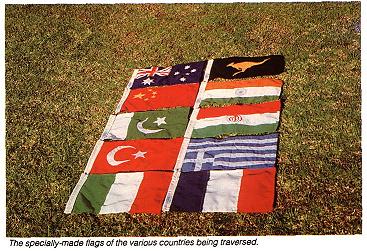
1997 Peking-Paris Motor Challenge: Leg One
RROC(A) Online Library
RROC(A) Main Page
 Our own criteria were that the car should be altered
as little as possible and should be left in a state
so that it could be returned to pristine condition
at the end of the rally. We have no intention of
seeing this car destroyed or even damaged. All
of the modifications made to the car are reversible but
some of the modifications have so improved the car
that they will not be altered and I will come to this later on.
Our own criteria were that the car should be altered
as little as possible and should be left in a state
so that it could be returned to pristine condition
at the end of the rally. We have no intention of
seeing this car destroyed or even damaged. All
of the modifications made to the car are reversible but
some of the modifications have so improved the car
that they will not be altered and I will come to this later on.


 It was thought prudent to change the radiator core.
In addition to this two auxiliary electric fans
were put on the front of it to provide extra cooling.
One of the problems of high altitude would be
boil-off of coolant and rupture of the cooling system.
All new radiator hoses have been fitted in
association with the new radiator core.
It was thought prudent to change the radiator core.
In addition to this two auxiliary electric fans
were put on the front of it to provide extra cooling.
One of the problems of high altitude would be
boil-off of coolant and rupture of the cooling system.
All new radiator hoses have been fitted in
association with the new radiator core.
 The car has been modified to cater for bad road
conditions. Three skid plates have been placed
under the car. One for the front of the engine
particularly to protect the very vulnerable steering
ram which sticks out under the front bumper. The
skid plate in the front has been curved up in
front of the bumper to provide a nudge bar and
also to protect the steering ram and the chrome
bumper A second skid plate has been fitted on the
gearbox and sump and a small third one has
been placed on the differential The front suspension
was modified by putting spacers under the
coil springs to lift the car about 1 cm and to
match the rear of the car. The rear was modified by
fitting a supplementary spring leaf. This is a
full length leaf spring. Thus there are now two led
springs on each side carrying the weight onto
the shackles. This also had the effect of lifting the
rear of the car about 1 cm. Apart from giving
extra ground clearance this
has improved the handling of
the car enormously. It no longer wallows
and accepts going around corners. The exhaust
system was then taken off the car completely
and a new exhaust system built. This has been
made in stainless steel and is recessed into the
chassis. There is no underhung exposure for the
exhaust system so that it cannot be pulled off by
rocks when the car bottoms in gutters.
The car has been modified to cater for bad road
conditions. Three skid plates have been placed
under the car. One for the front of the engine
particularly to protect the very vulnerable steering
ram which sticks out under the front bumper. The
skid plate in the front has been curved up in
front of the bumper to provide a nudge bar and
also to protect the steering ram and the chrome
bumper A second skid plate has been fitted on the
gearbox and sump and a small third one has
been placed on the differential The front suspension
was modified by putting spacers under the
coil springs to lift the car about 1 cm and to
match the rear of the car. The rear was modified by
fitting a supplementary spring leaf. This is a
full length leaf spring. Thus there are now two led
springs on each side carrying the weight onto
the shackles. This also had the effect of lifting the
rear of the car about 1 cm. Apart from giving
extra ground clearance this
has improved the handling of
the car enormously. It no longer wallows
and accepts going around corners. The exhaust
system was then taken off the car completely
and a new exhaust system built. This has been
made in stainless steel and is recessed into the
chassis. There is no underhung exposure for the
exhaust system so that it cannot be pulled off by
rocks when the car bottoms in gutters.
 Virtually no modifications have been made to the
interior of the car. It has been left au naturel. The
boot has been modified. In addition to the auxiliary
fuel tank it now has a second battery with an
isolator switch between the batteries. The batteries
have been set up so that both will charge but
with a relay to make sure that they do not overcharge.
New Apollo batteries with 625 CCA power
have been fitted to give adequate cranking power.
The cover on the floor of the boot has been
removed to allow the insertion of a second spare
tyre with tie down bolt eyes to secure it. This has
left a rather cluttered boot but will be adequate
for a workshop for the trip. Our luggage will be
carried in soft bags in front of the rear scat. Under
the air conditioning outlet in the front of the car
are two new devices. One is a switch for the auxiliary
petrol tank, hidden fairly well from view,
and the other more prominently displayed is an odometer.
This has been attached into the
speedometer cable at the gearbox and gives us trip
distance readings which are now accurately
calibrated as well as average speeds and intermediate
trip distances. This device is really essential
for navigating to keep us on the straight
Virtually no modifications have been made to the
interior of the car. It has been left au naturel. The
boot has been modified. In addition to the auxiliary
fuel tank it now has a second battery with an
isolator switch between the batteries. The batteries
have been set up so that both will charge but
with a relay to make sure that they do not overcharge.
New Apollo batteries with 625 CCA power
have been fitted to give adequate cranking power.
The cover on the floor of the boot has been
removed to allow the insertion of a second spare
tyre with tie down bolt eyes to secure it. This has
left a rather cluttered boot but will be adequate
for a workshop for the trip. Our luggage will be
carried in soft bags in front of the rear scat. Under
the air conditioning outlet in the front of the car
are two new devices. One is a switch for the auxiliary
petrol tank, hidden fairly well from view,
and the other more prominently displayed is an odometer.
This has been attached into the
speedometer cable at the gearbox and gives us trip
distance readings which are now accurately
calibrated as well as average speeds and intermediate
trip distances. This device is really essential
for navigating to keep us on the straight
 and narrow. All of the notes of the navigation will be given
in kilometres and our speedometer is in
miles so this device is necessary. A second horn button
has been added for the navigator to use.
The horn has been boosted with two additional horns and
operating them also turns on the high
beam headlights.
and narrow. All of the notes of the navigation will be given
in kilometres and our speedometer is in
miles so this device is necessary. A second horn button
has been added for the navigator to use.
The horn has been boosted with two additional horns and
operating them also turns on the high
beam headlights.
 This car is now well prepared and we hope to make the
trip of 10,000 miles between Pads and
Peking without any need for anything other than routine
servicing. I would like to acknowledge the
expertise of John Vawser is preparing this car. He has
done most of the real work. The has been
supplemented by help from Pew Muir at Bond Rollbars. He
did the undercarriage work.
This car is now well prepared and we hope to make the
trip of 10,000 miles between Pads and
Peking without any need for anything other than routine
servicing. I would like to acknowledge the
expertise of John Vawser is preparing this car. He has
done most of the real work. The has been
supplemented by help from Pew Muir at Bond Rollbars. He
did the undercarriage work.
